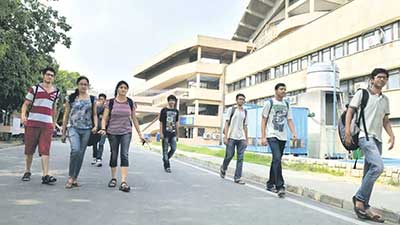Date: 29/11/2022
Relevance: GS-2: Issues relating to development and management of Social Sector/Services relating to Health, Education, Human Resources.
Key Phrases: New Education Policy 2020 (NEP, 2020), Ministry of Education, Human Resource Management (HRM), clarity of educational vision, Strategy and policy on inclusion, programme choices.
Context:
- From over 60,000 (high-quality higher education institutions) HEIs in India, not more than 5% would be of high quality, and perhaps another 5% nearabout.
- There are a significant number of teachers and students in the other 90% who will more than qualify as high quality with that definition, but their HEI would fail on an average basis.
Definition of a high-quality HEI:
- The graduates from a HEI must have a good understanding of their area of study and the ability to apply it to address real-world problems as well as the commitment to be engaged citizens.
- The HEI must have real institutional strength, with clarity of educational vision and the organizational structure and processes to implement it.
Purpose of the HEI:
- A HEI aligns and energizes everything and its absence leads to incoherence and drift.
- This purpose must be at the core of three inextricably linked matters which must be taken care of by its founders.
Determinants of a High Quality HEI:
- Programmes:
- The founders must be clear about the programmes to be run by the HEI which must arise from the purpose.
- ‘Programmes’ refers to diploma, undergraduate, graduate or other teaching programmes across disciplines or fields such as science, social science, engineering, etc.
- The curricula must then be informed by the purpose.
- Strategy and policy on inclusion:
- There must be clarity on the policy of inclusion of the economically disadvantaged. This too must arise from the purpose.
- Funding:
- The founders must arrange for adequate funding to begin with and have a realistic financial model which they stabilize.
- Many founders do not sort this out and the HEI struggles.
- Appointment of the institution’s leader: Vice-chancellor or Director:
- Unless the leader is entirely aligned with the purpose and values of the founders, it is impossible to develop a good HEI and sustain it.
- With the right leader, the operating team has the best chance of tackling its multidimensional challenges.
Issues with the HEIs:
- Many founders of HEIs do not pay adequate attention to the details of how their programme and inclusion choices are connected with the financial model.
- Thus, they are unconscious of the core issue that HEIs cannot be financially sustainable just on student fees.
- Across the world, HEIs are able to recover only 10-50% of their expenses from student fees, and the rest is supported by returns on the corpus (endowment) or by public financing.
- That range of recovery from student fees is determined by the programme choices and inclusion policy.
- Programme fee is based on what other HEI’s offer, and more fundamentally on employment opportunities after that programme.
- Even at the top end of the range in India, say, engineering at IITs, institutions are able to recover only about 20% of operating expenditure from fees.
- Thus, the financial sustainability, programme choices, strategy and policy on inclusion must be finely crafted.
External factors determining the cost structure of HEIs:
- Faculty compensation constituting a large part of the cost is driven by salaries in the public university system.
- The faculty-student ratio must be based on what is educationally sound.
- Other operating costs include facilities maintenance, admissions and student activities.
- Any good HEI must invest a part of its faculty’s time in research, so they remain updated in their field else teaching suffers.
Conclusion:
- In summary, the founders must decide what programmes the HEI will run and how inclusive the institution will be.
- On that basis, they must generate a corpus that can sustain the HEI. This fine balance is not merely a financial matter. It strikes at the very heart of the purpose of that particular HEI.
- This balance requires continuous work till the HEI stabilizes, which may take 10 to 15 years.
- A similar situation exists with public institutions. In their case, the relevant government commits itself to supporting what the corpus would in a private institution.
Source: Live Mint
Mains Question:
Q. What are the various determinants of a high quality higher education system(HEI)? Discuss the various issues faced by the HEIs in India. (150 words).






















